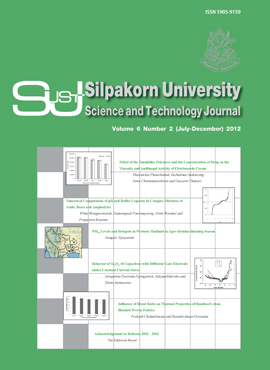Numerical Computation of pH and Buffer Capacity in Complex Mixtures of Acids, Bases and Ampholytes
Main Article Content
Abstract
This study was aimed to simplify the pH calculation for complex mixtures of acids, bases andampholytes; the theoretical concept on pH calculation was renovated. A new algorithm was proposed tostate that buffer capacity (b) could be simultaneously achieved with pH. To validate the method, the buffersystems of Na2HPO4/NaH2PO4 and Na2HPO4/citric acid were employed. Acid and base titration was doneon the buffer systems using HCl and NaOH, respectively. It was demonstrated that only the charge balanceequation (CBE) was necessary and sufficient to successfully compute b. To achieve the desirable accuracy,the pH interval used in such algorithm should be 10-4 for general calculation; between 10-4 and 10-2 for 8significant-digits calculation; between 2 x 10-10 and 4 x 10-4 for 16 significant-digits calculation. Visual BasicSource Code written in Microsoft AccessTM for demonstrating computation of pH and b of pure water was also illustrated.
Downloads
Article Details
References
Chung, C. C., Chen, H. H., and Ting, C. H. (2010). Grey prediction fuzzy control for pH processes in the food industry. Journal of Food Engineering, 96: 575-582.
Coiffard, C. A., Coiffard, L. J., and De Roeck-Holtzhauer, Y. M. (1997). Influence of pH on thermodegradation of thaumatin in aqueous solution. Food Research International, 30: 707-710.
Cutler, D. (1986). Calculation of pH for complex mixtures of acids, bases and ampholytes. Journal of Pharmacy and Pharmacology, 38: 499-501.
Dean, J. A. (1999). Lange’s Handbook of Chemistry, 15th ed., McGraw-Hill, New York.
Garcia-Gonzalez, L., Teichert, H., Geeraerd, A. H., Elst, K., Van Ginneken, L., and Van Impe, J. F., Vogel, R. F., Devlieghere, F. (2010). Mathematical modelling and in situ determination of pH in complex aqueous solutions during high-pressure carbon dioxide treatment. The Journal of Supercritical Fluids, 55: 77-85.
Heyrman, A. N. and Henry, R. A. (nd), Importance of controlling mobile phase pH in reversed phase HPLC. [Online URL: www.hplcsupply.com/pdf/App_9.pdf.] accessed on January 14, 2011.
Mathews, J. M. (1987). Numerical Methods for Computer Science, Engineering, and Mathematics, pp.64-65. Prentice-Hall, London.
Obata, K., Sugano, K., Saitoh, R., Higashida, A., Nabuchi Y., Machida, M., and Aso, Y. (2005). Prediction of oral drug absorption in humans by theoretical passive absorption model. International Journal of Pharmaceutics, 293: 183-192.
Sinko, P. J. (2010). Martin’s Physical Pharmacy and Pharmaceutical Sciences, 6th ed., pp. 163-181. Lippincott Williams & Wilkins, Philadelphia.
USP24 (2000). The United States Pharmacopeia 24, pp.2231-2232. The United States Pharmacopeial Convention, Maryland.
York, P. (2002). The design of dosage forms, In Pharmaceutics: The Science of Dosage Form Design (Aulton, M.E., ed.), 2nd ed., pp.1-12. Churchill Livingstone, London.


